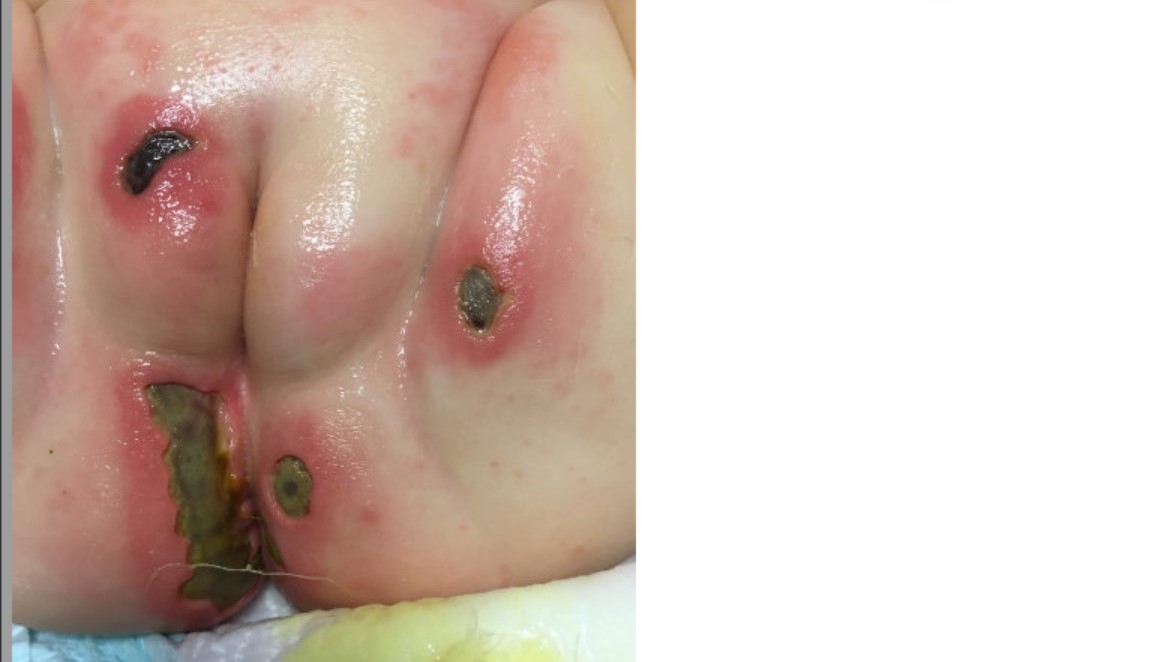Case Presentation: A previously healthy 8 month old female presented to the emergency department (ED) with diarrhea and an unusual diaper rash. Her symptoms began 6 days prior to presentation with fever and congestion. She was initially diagnosed with a viral upper respiratory infection and bilateral otitis media and was prescribed cephalexin. She later developed diarrhea and a red diaper rash which progressed to large areas of ulceration and necrosis. She was seen multiple times in the ED and was prescribed barrier cream and mupirocin ointment without improvement. HSV culture of the rash was negative. Cephalexin was changed to cefdinir due to concern for antibiotic induced diarrhea and eventually stopped after 5 days. Her laboratory studies on admission were significant for BUN of 24 mg/dL, creatinine of 0.73 mg/dL, hemoglobin of 9.1 g/dL, platelet count of 93 x 10^3/uL, and an absolute neutrophil count of 1.22 x 10^3/uL. Her physical exam showed multiple large areas of ulceration and necrosis surrounded by halos of erythema in the genitourinary region.
Infectious disease was consulted, and she was diagnosed with ecthyma gangrenosum (EG). Wound cultures and stool culture returned positive for Pseudomonas aeruginosa. Blood cultures were negative. Nasopharynx rhinovirus PCR was positive. An abdominal ultrasound showed right lower quadrant inflammatory enteritis.
She was started on piperacillin/tazobactam, and her wounds were surgically debrided. Intraoperative tissue cultures were positive for Pseudomonas aeruginosa. Evaluation for underlying immunodeficiency was negative with normal immunoglobulins, negative HIV testing, normal oxidative burst assay, and normal T and B lymphocyte immunophenotyping. She had resolution of her diarrhea and improvement in the appearance of her wounds. Her acute kidney injury, neutropenia, and thrombocytopenia resolved, but she continued to have mild anemia. She was transitioned to oral ciprofloxacin to complete a 14 day course and recovered uneventfully.
Discussion: Ecthyma gangrenosum is classically associated with Pseudomonas aeruginosa bacteremia in immunocompromised patients. Most cases occur in patients with chronic disease or underlying immunodeficiency, but there are case reports describing healthy patients with this diagnosis.
In this patient, rhinovirus infection and recent antibiotic use likely led to her susceptibility to EG. Rhinovirus infection may have led to general suppression of the immune system and neutropenia. Pseudomonas is a natural colonizer of the gastrointestinal tract, and antibiotic use may allow for overgrowth of Pseudomonas and subsequent infection.
Conclusions: While typically associated with immunocompromised patients, EG can present in previously healthy individuals. Risk factors for infection in otherwise healthy patients include preceding viral infection, recent antibiotic use, and transient neutropenia. EG may also be the presenting condition in a patient with an underlying immune deficiency, thus an immunologic evaluation should be pursued.

